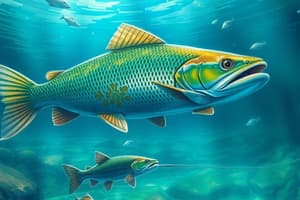Podcast
Questions and Answers
What is a fishery?
What is a fishery?
- A type of fish market
- A type of fishing gear
- A fish species
- An area where fish and other seafood are caught or harvested (correct)
What type of fishery targets high-value species?
What type of fishery targets high-value species?
- Artisanal fisheries
- Small-scale fisheries
- Industrial fisheries (correct)
- Recreational fisheries
What is sustainable fishing?
What is sustainable fishing?
- Fishing that maintains or increases the long-term health of fish populations (correct)
- Fishing that depletes fish populations
- Fishing for recreational purposes
- Fishing that targets low-value species
What is bycatch?
What is bycatch?
What is the purpose of fishing quotas?
What is the purpose of fishing quotas?
What is the purpose of marine protected areas?
What is the purpose of marine protected areas?
Flashcards are hidden until you start studying
Study Notes
Definition
- A fishery is an area where fish and other seafood are caught or harvested.
Types of Fisheries
- Industrial fisheries: large-scale commercial fishing operations that target high-value species.
- Small-scale fisheries: smaller, local fishing operations that often target lower-value species.
- Recreational fisheries: fishing for sport or pleasure, often with limited catch limits.
- Artisanal fisheries: traditional, small-scale fishing practices, often using low-tech gear.
Fishery Management
- Sustainable fishing: fishing practices that maintain or increase the long-term health of fish populations.
- Overfishing: removing too many fish, depleting the population and potentially causing ecosystem damage.
- Fishery management: regulations, quotas, and monitoring to ensure sustainable fishing practices.
Fishery Impacts
- Bycatch: catching non-target species, including endangered or protected species.
- Habitat damage: damage to marine habitats, such as coral reefs or seagrass beds, from fishing gear or practices.
- Food security: fisheries providing a source of protein for human consumption.
Fishery Management Tools
- Catch shares: allocating a percentage of the total allowable catch to individual fishermen or groups.
- Marine protected areas: designating areas where fishing is restricted or prohibited to protect habitats or species.
- Fishing quotas: limiting the amount of fish that can be caught by a fishery or individual fishermen.
Definition of Fisheries
- A fishery is an area where fish and other seafood are caught or harvested.
Types of Fisheries
- Industrial fisheries are large-scale commercial fishing operations that target high-value species.
- Small-scale fisheries are smaller, local fishing operations that often target lower-value species.
- Recreational fisheries involve fishing for sport or pleasure, often with limited catch limits.
- Artisanal fisheries are traditional, small-scale fishing practices that often use low-tech gear.
Sustainable Fishing Practices
- Sustainable fishing maintains or increases the long-term health of fish populations.
- Overfishing involves removing too many fish, depleting the population and potentially causing ecosystem damage.
- Fishery management involves regulations, quotas, and monitoring to ensure sustainable fishing practices.
Environmental Impacts of Fisheries
- Bycatch refers to catching non-target species, including endangered or protected species.
- Habitat damage occurs when fishing gear or practices damage marine habitats, such as coral reefs or seagrass beds.
- Fisheries provide a source of protein for human consumption, contributing to food security.
Fishery Management Tools
- Catch shares allocate a percentage of the total allowable catch to individual fishermen or groups.
- Marine protected areas are designated areas where fishing is restricted or prohibited to protect habitats or species.
- Fishing quotas limit the amount of fish that can be caught by a fishery or individual fishermen.
Studying That Suits You
Use AI to generate personalized quizzes and flashcards to suit your learning preferences.




